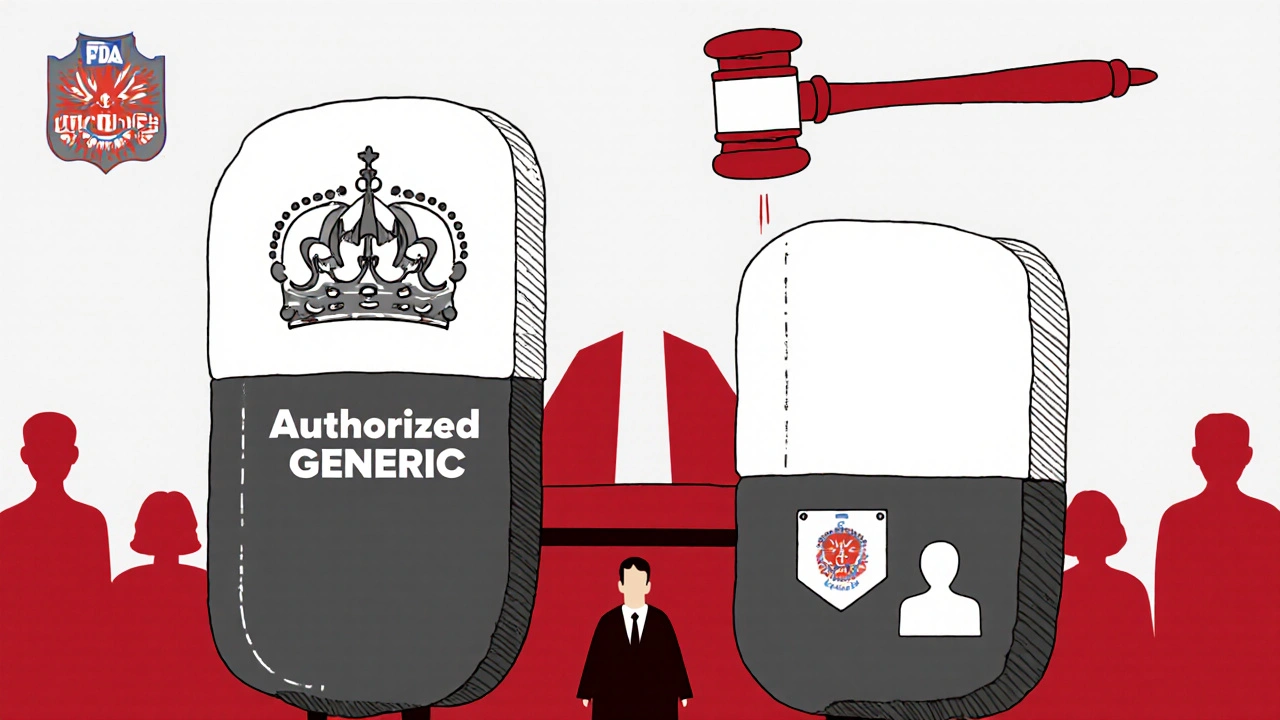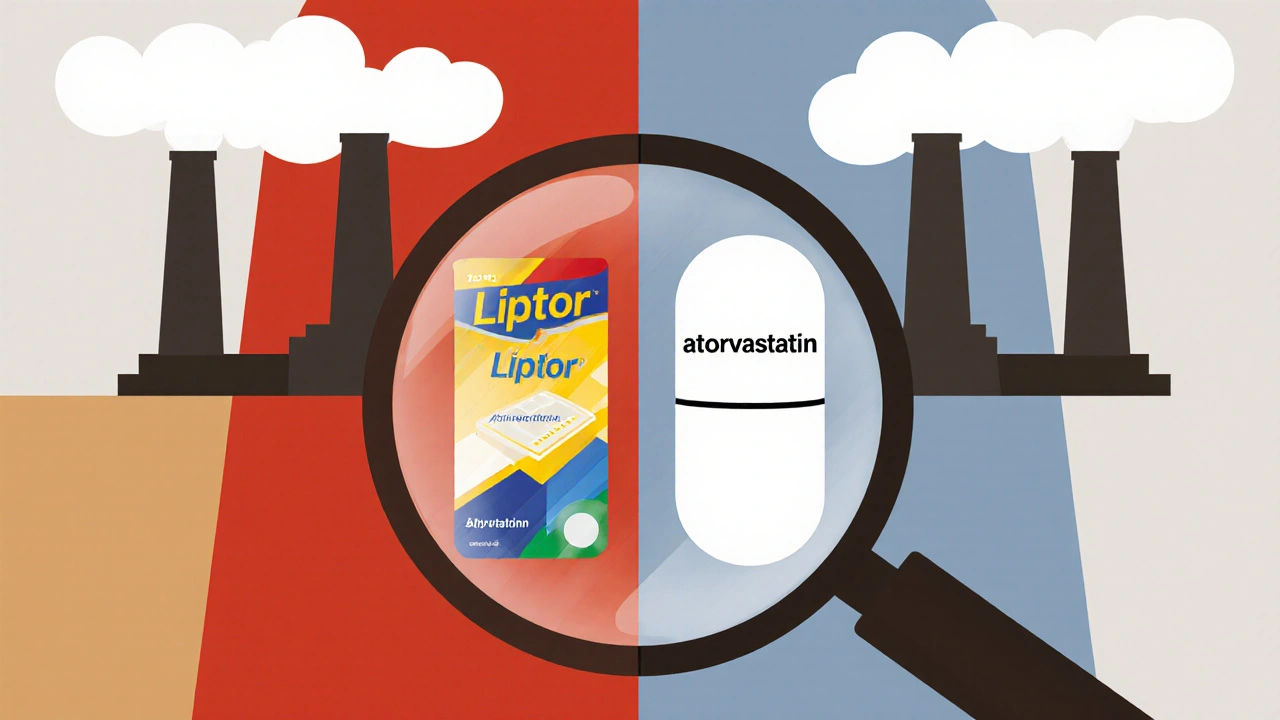When you pick up a prescription, you might see two pills that look completely different - one with a fancy brand name, another with a plain label. You might wonder: are they really the same? The answer, in many cases, is yes. Especially when it comes to authorized generics.
What Exactly Is an Authorized Generic?
An authorized generic is not a copy. It’s not a look-alike. It’s the exact same pill, capsule, or liquid that comes in the branded box - just without the brand name on it. The FDA defines it clearly: an authorized generic is a brand-name drug sold under the original drug’s approval, with no changes to the formula, strength, or ingredients. The only difference? The label doesn’t say "Lipitor" or "Zoloft." It just says "atorvastatin" or "sertraline." These aren’t made by some third-party company trying to reverse-engineer the formula. They’re made by the same factory, on the same machines, with the same batch of active and inactive ingredients as the brand-name version. Sometimes, the brand company sells it themselves. Other times, they license it to a subsidiary or partner. But the product? Identical.How Is It Different From a Regular Generic?
This is where things get confusing. Most people think "generic" means "same as brand." But that’s not always true. Regular generics - the kind you see on pharmacy shelves every day - are approved through an Abbreviated New Drug Application (ANDA). To get approval, they must prove they’re bioequivalent to the brand drug. That means the active ingredient is absorbed into your bloodstream at a similar rate and amount. But here’s the catch: the inactive ingredients - things like dyes, fillers, and preservatives - can be different. For most people, that doesn’t matter. But for some? It does. People with allergies, sensitivities, or digestive issues might react to a different dye or binder in a regular generic. That’s why some patients report feeling different after switching - even when the active ingredient is the same. Authorized generics solve that problem. Because they’re made under the brand’s original New Drug Application (NDA), they use the exact same inactive ingredients. No substitutions. No surprises. If your brand-name drug has a red dye, the authorized generic has the same red dye. Same coating. Same shape. Same size. Same everything.Why Do Brand Companies Sell Authorized Generics?
You might think brand companies would fight generics tooth and nail. After all, generics cut into their profits. But here’s the twist: many brand companies actually make and sell authorized generics themselves. Why? It’s a smart business move. When a patent expires, other companies can launch their own generics. That drives prices down fast. But if the brand company launches its own authorized generic at the same time, they can capture part of that market - often at a price higher than traditional generics but still lower than the brand name. This strategy helps them keep some revenue while still offering a cheaper option. It also reduces the risk of patients switching to a competing generic that might have different inactive ingredients. Some experts call it a "defensive move." Others call it a way to control the market. Either way, it’s real - and it’s happening more often.Are Authorized Generics Cheaper Than Brand Drugs?
Yes - but not always as cheap as you’d hope. Brand-name drugs can cost 80-85% more than traditional generics, according to GoodRx data from 2023. Authorized generics usually sit in the middle. They’re cheaper than the brand, but often more expensive than the standard generic. You might pay $15 for the brand, $8 for the regular generic, and $12 for the authorized generic. That might seem odd. Why pay more for something that’s identical? The answer: insurance. Many insurance plans treat authorized generics the same as traditional generics - meaning your copay is the same. So even if the price is higher, your out-of-pocket cost might not be. Some pharmacies even stock them side-by-side. If you’re on a tight budget, ask your pharmacist: "Is there a traditional generic available?" But if you’ve had issues with side effects from regular generics before, the authorized version might be worth the extra few dollars.What Do Doctors and Pharmacists Say?
Most doctors and pharmacists agree: authorized generics are therapeutically equivalent to the brand. The FDA says so. The American Academy of Allergy, Asthma & Immunology says so. A 2018 study published in the National Center for Biotechnology Information tracked over 5,000 patients switching from brand to generic or authorized generic. It found no meaningful difference in hospital visits, emergency room trips, or medication adherence between the two. But here’s what they also say: patients are confused. Pharmacists report that about 30% of patients question why they’re getting a different-looking pill. Some think it’s a lower quality. Others worry it’s not as strong. That’s not because the medicine is different - it’s because they don’t understand the system. Good pharmacists take the time to explain: "This is the same drug your doctor prescribed. It’s just sold without the brand name. You’ll get the same results."When Should You Choose an Authorized Generic?
Here’s a simple guide:- Choose an authorized generic if: You’ve had a bad reaction to a regular generic - like a rash, stomach upset, or headaches - and you suspect it’s due to inactive ingredients. You want the exact same formula as your brand drug. Your insurance covers it at the same cost as a regular generic.
- Stick with a regular generic if: You’ve never had an issue with generics before. You’re trying to save the most money possible. Your doctor hasn’t flagged any sensitivity concerns.
- Ask your doctor to write "DAW" (Dispense As Written) if: You specifically want the brand or authorized generic and don’t want the pharmacy to substitute anything. This is especially important if you’re sensitive to fillers or dyes.

Can You Trust Authorized Generics?
Absolutely. The FDA doesn’t approve them like regular generics. They don’t need to. They’re already approved - because they’re the same product. No testing for bioequivalence is needed. No guesswork. No assumptions. Just the same pill, same factory, same quality control. Patients who’ve switched report no change in effectiveness. One user on a patient forum wrote: "I’ve been on the authorized generic of Xyzal for two years. Same results. Same side effects. Same everything. I didn’t even notice until I checked the bottle." And if you’re worried about safety? The FDA monitors authorized generics just like brand drugs. If there’s a problem, they recall it - just like they would with the brand.What’s Changing in 2025?
The landscape is shifting. More brand companies are launching authorized generics as a way to hold onto market share. At the same time, regulators are paying closer attention to pricing. Some authorized generics are priced only 15-20% below the brand - not the 80% discount you’d expect. The FDA is considering requiring these products to be listed in the Orange Book - the official database of approved drugs - so patients and providers can easily identify them. That could make it easier to track which versions are available and at what price. There’s also talk in Congress about limiting how brand companies use authorized generics to block competition. The Affordable Prescriptions for Patients Act of 2023 proposed rules to stop manufacturers from using these products to delay cheaper generics from entering the market. But for now? If you’re looking for a safe, reliable, and identical alternative to your brand-name drug, an authorized generic is one of the best options available.How to Find One
You won’t always see "authorized generic" on the bottle. But you can ask your pharmacist directly:- "Is there an authorized generic for this drug?"
- "Is this the same as the brand, just without the name on it?"
- "Can you check if the manufacturer is the same as the brand?"
Are authorized generics as safe as brand-name drugs?
Yes. Authorized generics are made under the same FDA-approved process as the brand-name drug, using the exact same ingredients, manufacturing process, and quality controls. The only difference is the label. The FDA confirms they are therapeutically equivalent and carry the same benefits and risks.
Why is an authorized generic sometimes more expensive than a regular generic?
Because it’s often sold by the same company that makes the brand-name drug. They may price it higher than a competing generic to maintain some profit margin, even though the product is identical. Insurance plans usually cover it at the same tier as a regular generic, so your out-of-pocket cost may still be low.
Can I switch from a brand drug to an authorized generic without consulting my doctor?
In most cases, yes - if your prescription doesn’t say "DAW" (Dispense As Written). Pharmacists can substitute authorized generics just like regular generics. But if you’ve had issues with other generics before, or if your condition is sensitive (like epilepsy or thyroid disease), it’s best to check with your doctor first.
Do authorized generics have the same side effects as brand-name drugs?
Yes. Because they contain the exact same active and inactive ingredients, the side effect profile is identical. If you’ve experienced side effects with the brand, you’ll likely experience the same ones with the authorized generic - and vice versa.
How do I know if my medication is an authorized generic?
Check the label for the manufacturer’s name. If it’s the same company that makes the brand-name drug - like Pfizer or AstraZeneca - it’s likely an authorized generic. You can also ask your pharmacist or search the FDA’s authorized generic list. Some pharmacies will label it as "authorized generic" on the bottle or receipt.
